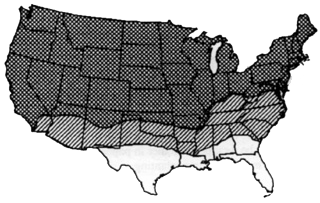Greenhouse
| Container .............. | Bench or flat deep enough to allow root development |
| Media ................... | Sand or soil mixture |
| Temp/Light ............ | 24 to 30°C; 16+ hour daylength |
| No. of Plants ......... | 50 to 70 per replication |
| No. of Reps ........... | 3 minimum |
| Other .................... | Inoculate with Rhizobium meliloti Dang;
promote good growth; spray and fertilize as necessary |
| INOCULUM CULTURE | |
| Source ................. | Infected root tissue |
| Storage................. | Ground up, washed roots |
| Temperature ......... | -10°C |
| Storage Life .......... | Up to several years if frozen |
| INOCULATION PROCEDURE | |
| Age of Plant........... | 8 weeks old |
| Concentration ........ | 50g ground root per lL H2O |
| Inoc. Time ............. | 20 to 30 min |
| Method ................. | Bare root soak |
| Type of Inoc........... | Bacterial water suspension |
| INCUBATION | |
| Location................ | Transplant to field (June) |
| Plant Counts.......... | Count 2 to 4 weeks after establishment |
| Cultural ................. | Maintain vigorous growth |
| Spacing ................ | 0.15 x 1.0 m |
| Age at Rating ........ | 5 months (3 months in field) |
| RATING | |
| Plants are removed from the field and the tap root sectioned for rating. | |
| 0 Resistant ........... | Root clean and white |
| 1 Resistant ........... | Very small yellow-brown spots visible in stele |
| 2 Susceptible ........ | Discoloration affecting up to one-third of stele |
| 3 Susceptible ........ | Nearly entire stele discolored, cortex white |
| 4 Susceptible ........ | Discoloration throughout slele and cortex, plant alive |
| 5 Susceptible ........ | Plant dead (based on plant count) |
CHECK CULTIVARS
Approximate Expected Resistance (%) |
Acceptable Range of Reaction (%) |
|
Resistant |
||
Vernal** |
42 |
30-50 |
Susceptible |
||
Narragansett** |
1 |
0-5 |
Sonora** |
1 |
0-5 |
| Values for resistant standards are totals of 0's and l's. | ||
|
DISTRIBUTION AND SEVERITY OF Bacterial wilt, Clavibacter michiganense subsp. insidiosum (McCull) Davis et al SOURCE
OF INOCULUM
RACES |
||||||||||||||||||
